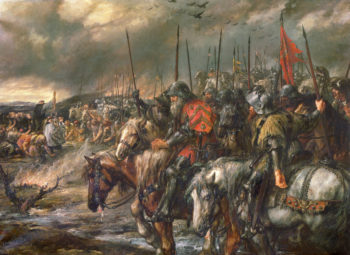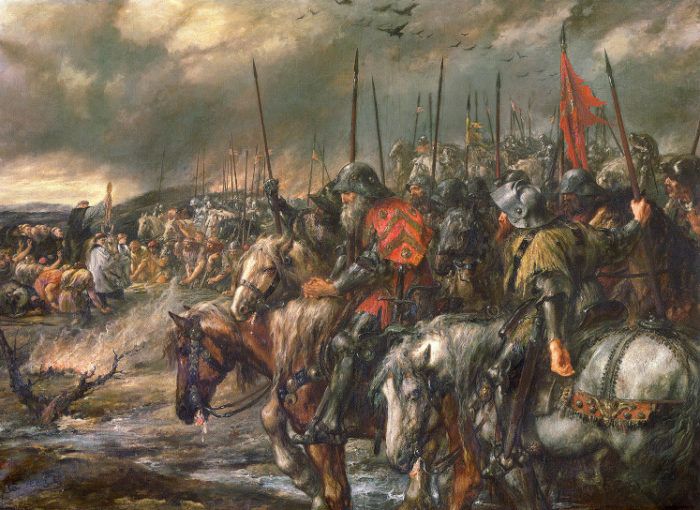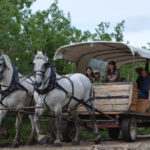Speculative Fiction Writers Guide to War, part 18: War Costs Exercise 1–Food for the Army
Travis P here. In spite of the original date of this post, nothing we say has any direct connection to Valentine’s Day or romance (sorry!). Instead we’re continuing on with providing you a set of numbers you can use, if you ever chose to do so, in order to calculate what an army needs. My fellow Travis is leading the way this week:
Travis C here. As you saw last week, this topic is huge, and rather than try and combine informational content with illustration, we’re going to split things up for a bit. Travis P introduced us to food supplies over the ages. He covered a spectrum of periods and practices from ancient days till modern times and speculated upon futuristic scenarios in sciences fiction and fantasy environments.
This week, I want to build an example calculation using data that he provided along with some other resources. I’ll keep the story going as we discuss varying forms of supply and support, capital costs, and other cost-of-war-related themes. This post will accomplish two purposes: first, to give you a story context and second, to develop a relative cost estimate based on Travis P’s food post last week and how that might influence a story.
My entering assumptions:
Fantasy worlds are often modeled after the Middle Ages as we perceive them, ranging from the Dark Ages through the High Middle Ages. Because of the interesting data available for this time period, I used the time of the Hundred Year’s War, the 1415’s specifically. Several factors impact these calculations that don’t necessarily “scale,” but it was a place to start from. (Note that futuristic science fiction story worlds would be better modeled based on the needs of armies from our own times.)

Morning of the Battle of Agincourt, 25 October 1415, painted by Sir John Gilbert in the 19th century
For medieval warfare, two types of activity dominate: putting armies in the field, and castle warfare (i.e., occupation politics). For castle warfare, we have both a defensive mode, building castles to preserve or hold a condition, and an offensive mode where castles are used as a strong base of operations from which to launch expeditions. We’ll start with fielding an army.
The purpose of this exercise is to develop enough information about the logistics of an activity in warfare so my story can be told without the reader assuming unbelievable events and to see if the logistics of a war can be used to develop interesting plot points, tension, and conflict. This exercise might be a starting place if I were to write a military fantasy, but as we’ll see, this will be insufficient to satisfy the superfan of that genre.
When we get to it, we’ll base our currency off the English system and maintain similar relative values to the 1400’s:
1 pound (£1) = 20 shillings (20s)
1 crown = 5 shillings (5s)
1 shilling = 12 pence (12d for denarius)
Scenario: Lady Katie and the Mad King Crabcakes
The Queen of New Landia, the Lady Katie, is in trouble. The neighboring realm of Old Seaside has made a claim on the throne of her realm and rallied their banners to wage war against her own baronesses and herself. She has firm control of lands surrounding the capital city, Awesomeness, but her border with Old Seaside is relatively unprotected and vaguely defined by a forest. Wide rivers defend her remaining borders.
Rumors from her spies indicate the Mad King Crabcakes can field an army of 500 horse, 3000 foot, and 2000 archers plus attendants and that he plans to launch a major campaign within a year while testing New Landia’s defenses in the meantime. The strength of King Crabcakes’ forces drops significantly away from his stronghold on the coast, but there are at least 6 minor and 3 major fortifications between her border and King Crabcakes’ stronghold.
Clearly there’s a lot left missing, but let’s go with this until we need to create more. Lady Katie must face a hard choice to begin with: does she meet the Mad King in the field, or does she put up a strong defense through building or capturing castles? Either method will cost her time and money and she’s limited in both. She gathers her advisers to assess the situation. For this post, we will only look at the first of her options.
Fielding an Army
Like all good rulers, noble Lady Katie knows her baronesses and the condition of their lands. Clearly, Lady Katie needs to draw forces if she meets Crabcakes in the field. Her advisers suggest she wants at least a 10% greater force to assure victory, so she’s trying to field 550 horse, 3300 foot, and 2200 archers. Plus all the support services necessary to remain afield for no less than 6 months (we’ll assume the fighting season lasts 6 months and then, by traditional obligation, she allows vassals to return home, necessitating the length of the campaign.) We’ll exercise our endothermic assumptions by fielding a dozen sapient war wolves, and to further challenge our ectothermic assumptions, she gains access to a dragon to lock up her chances.
I think we’ll delve into this in future posts, but let’s make a couple of assumptions to get us an army to put in the field, and some conditions she and her advisers will consider when calculating the cost of food:
1) When we say 550 horse, we’ll assume 400 knights and 150 skirmishing-capable riders (for pickets, scouts, messengers, and skirmishing duties.) Each knight has at least two attendants (squire/pages) in the field, and three horses (a warhorse, a riding horse, and a pack horse). At this point, we’ll assume the attendants will not have their own mounts. The skirmishing force each require two horses for their duties.
Total knights: 400
Total attendants for the knights: 800
Total skirmishers: 150
Total number of horses: 1500 (we’ll un-conservatively assume a horse is a horse, of course. That’s not true, as a charger’s needs will vary compared to palfreys, coursers, and pack animals.)
Lady Katie gets these through her baronesses as a feudal obligation. We’ll discuss their cost later.
2) The 3300 foot come from various sources. Some are her standing forces that occupy her lands’ castles and fortifications, which she draws down to provide soldiers for the army (let’s assume 300 of them). 2000 will come from feudal obligations from her baronesses’ lands. Another 1000 will be paid soldiers from other lands performing as mercenaries. She’ll pay for these via scuttage that we’ll discuss when we talk wages. While the majority of these soldiers will travel afoot, some portion do have horses to be used for their unit’s obligations. Let’s assume that’s 5% of the non-garrison force.
Total foot soldiers: 3300 (1000 mercenaries)
Total number of horses: 150
3) The 2200 archers come from her land’s feudal obligations as well, as every person is expected to shoot on Sundays by tradition. Half of this force have horses (one per soldier) to enable rapid deployment across the battle space, the remainder are afoot.
Total archers: 2200
Total number of horses: 1100
So just the regular fighting forces, not logistics support or engineers or anything else (other than squires), we end up with:
Total soldiers to feed: 6850
Total horses to feed: 2750
How much food?
Let’s look at the horses first. We may revisit this topic, and I don’t intend to provide a rigorous analysis of horse use in combat at this point, but according to a World War I source on horse care, I’ll use a median value of 11 lbs of oats and 10 lbs of fodder for each horse every day (irrespective of type; clearly an incorrect assumption, but sufficient for now).
2750 horse x 11 lbs oats = 30,250 lbs per day
2750 horse x 10 lbs fodder = 27,500 lbs per day
At 2500 lbs per wagon drawn by a brace of oxen, that’s about 12 wagons a day for oats, and 11 for fodder if it’s not available. Let’s assume she wants to have the horses forage for fodder to the maximum extent possible to extend her supplies. If I use a simple assumption that we can look at in more detail later that an acre of grass can produce 2000 lbs of fodder in a year, with a 9 month season it can be relied on for fodder, we can consume about 7.5 lbs per day per acre without leaving the land decimated. Lady Katie’s horses could consume as much as 3700 acres per day (about 5.8 square miles per day). Historical accounts suggest swaths of up to 10 miles wide being destroyed by a passing army, and now we can understand why.
Since in today’s market, wheat is about twice as expensive as oats, I’m using this reference to estimate my cost of oats at 4d/bushel, and a bushel of oats is about 32 lbs, so my daily cost of oats is:
30,250 lbs x (1 bushel / 32 lbs) x (4d / bushel) = 3781d, or 315s or £16/day
= ~ £2900 for a 6 month campaign (I’ve also found references that suggest this could be at least twice as high!)
For the people, let’s start with the simpler scenario: humans.
Using Travis P’s estimates from last week, I made some simple estimates for how much a person will consume per day:
1 loaf of bread @ 800 grams (this is higher than necessary)
⅕ of a chicken @ ~150 grams
1 qt of ale
1 qt of milk
Modify the costs by a factor of 150% to account for error, any supplements like sauces, etc.
Modify that result again by 150% for the knights assuming they will eat better fare
Estimate this all weights in around 5.5 lbs/person/day
Based on a mix of 1300’s prices (which we will share later), that works out to:
0.3 pence for bread
0.4 pence for chicken
0.2 pence for ale
0.05 pence for milk (assume ¼ the cost of ale)
Total: 0.95 pence x 1.5 = 1.425d (let’s round to 1.5 pence per soldier per day)
And lastly, 1.5 pence x 1.5 = 2.25d for nobles and knights
So with our merry band of 6450 human soldiers and 400 knights, we get:
1.5d x 6450 soldiers = 9675d, or 806s, or £40.
2.25d x 400 knights = about £4.
Let’s round that to £45 per day. In 2019, that seems cheap. If I use a simple relative conversion though, we see it’s pretty significant: in modern times, a loaf of bread alone costs about £0.25, or 60 pence a loaf, compared to our 0.3 pence. So that army costs a modern estimate of £9000 per day, or £1.6 million for our 6 month campaign! And think of everything we didn’t factor in:
Transport of the foodstuffs
Actual variability in the menu we purchased
Preparation, cooking, serving, clean-up
Any of our camp followers and support staff
Whether that food is immediately available when we want it
I want to check my math here and use a different measure, from a resource we will share in a future post:
Price in 1380 to feed each member of a household: lord, 7d; esquire, 4d; yeoman, 3d; and groom, 1d.
400 knights x 7d = 2,800 pence/day
6,450 soldiers x 3d = 19,350 pence/day (I lumped my squires into the yeoman category)
= 22,150d, 1,845s, £92/day (about twice what I estimated first)
= £16,600 for a 6 month campaign!
I’ll assume the higher amount for now to be conservative.
Endothermic Creature Calculation

Dire Wolves (an extinct species of very large wolf). Source: US National Park Service
Bear in mind that our standard Medieval figures only apply to creatures who actually lived in the medieval era. So how do we account for fictional creatures, like Lady Katie’s war wolves? I think we’ve got two possible approaches. She’s bringing a dozen in the field with her, and let’s say they weight in around 200 lbs (a little larger than the extinct species of dire wolves that once lived on Earth). The first thing we could do would be to scale up the average consumption of the closest living animal to our fictional creature, in this case a real wolf: our war wolf is a little more than 100% larger, and wolves consume around 10 lbs of meat per day (not necessarily in a single day though), so we can assume the war wolves will need twice that amount.
12 war wolves x 20 lbs meat/day = 240 lbs of meat per day
Based on assumptions about cows that follow, I can anticipate 1 cow lasting 3 days, so we need another 60 cows for a cost of about £25 for the campaign to feed the wolves. Alternatively, I could use Travis P’s recommendation on BMR and attempt to scale the caloric intake for our war wolves. Since the 200 pound figure I’ve been using equals about 90 kilograms, a BMR for a war wolf would amount to approximately 90 kilograms ^.75, but such a figure is so general that it would have the wolf wind up with the same approximate BMR as a 200 pound human!
While a war wolf weighs in near the size of a large man, for whom Travis P listed a figure of 2,500 calories per day as a reasonable calorie per day intake, my sense is a wolf will have higher caloric intake than a man. Travis P may have accounted for this by mentioning that creatures with higher metabolisms use more calories per hour than creatures with lower metabolisms. One way we would know if a creature has a higher metabolism is if its internal body temperature were higher than a human beings. Is that the case for wolves? According to one online source, the answer is no, because humans and wolves have the same internal body temperature, 37° C / 98.6° F.
The other way Travis P may have accounted for this was by mentioning that while humans rarely exceed more than twice BMR while active, many other creatures have a much higher multiple for their BMR when energetic. He stated the BMR for a healthy adult human male is “about” 1800 calories–let’s round up to 2000 for simplicity. A human working hard may double that caloric intake a day or possibly even go over double by a significant degree, but an active wolf may go much higher, perhaps as high as 4 to 5 times that amount, based on a comment Travis P made in the previous article. That would mean a war wolf would use approximately between 8,000 and 10,000 calories per day.
Based on the figure of approximately 1,100 calories in a pound of meat from the list of Colonial rations in last week’s post, that would mean a war wolf would require between 7 and 10 pounds (3.2 and 4.5 kg) per day of meat. Which is about half the figure obtained from the simpler calculation based on what wolves eat per day, though that figure came from a source that may have referenced what wolves eat when given the chance as opposed to their minimum needs.
In any case we now have two figures, one pointing at a minimum of about 10 pounds a day and the other at 20. To conservatively ensure we have enough food, we’ll use the figure of 20 lbs of meat per day.
Ectothermic Creature Calculation
Since in the story world of Lady Katie a dragon is an endothermic creature rather than an animal with a minimum BMR like a wolf, the kind of calculation we just did won’t really work here. Thankfully Travis P gave us some relief when considering ectothermic creatures. Since they cannot regulate their internal body temperature and rely on the environment, we have some thumb rules for how to calculate their caloric intake. We’ll use those estimates to gauge our dragon’s consumption costs.
I’ll approach this the simpler of two ways: using the example of the 300-some kg crocodile Travis P gave (as opposed to more thorough calculations using his breathing rates). I also will assume out of that 6 month campaign that the dragon is lazy (for which I will use the SMR for 10° C /50° F that Travis P gave) and active for 3 months (for which I will use the SMR for 30° C / 86° F), respectively. If it were our crocodile:
3 months x 30 days/month x 180 calories/day = 16,200 calories
3 months x 30 days/month x 720 calories/day = 64,800 calories
81,000 calories (the sum) x ~720 calories/300 grams of meat = 194.4 kg, or about 430 lbs.

Source: Naominovik.com
Now for my crocodile-to-dragon conversion: I’ll assume a 15 tonne (15,000 kg) dragon based on Naomi Novik’s Temeraire series and assume that caloric intake scales directly. Our crocodile weighs in at the upper end of the scale at 390 kg, so:
430 lbs of meat x (15,000 kg / 390 kg ) = ~16,500 lbs of edible meat
From my earlier reference, a good cow costs about 9s and we’ll assume I get ⅔ of the ~1300 lbs average weight of a range cow down our dragon’s gullet.
Number of cows for the six months = 16,500 lbs / 867 lbs/cow = 19 cows
Cost of cows = 9s/cow x 19 cows = 171s or about £8.5
In practice, this looks like 1 cow every 9 days or so. I suspect Lady Katie’s dragon will exert more energy because he will be more active in combat and require a full cow per day (if I were a dragon I wouldn’t work for any less).
Cost of cows for the dragon = 6 months x 30 days/month x 1 cow/day x 9s/cow = 1,620s or ~£80
Total Cost for 6 Months Afield
Let’s wrap this up and do a quick analysis:
Total food costs:
Soldiers: £16,600 (I’m going with our higher end estimate for conservatism)
Horses: £2,900
War wolves: £25
Dragon: £80
Total £19,605
Again, remember that Lady Katie has paid no wages, hired no combat support, nor provided for any form of logistics to get this food to the army, and this assumes she allows the horses to forage for fodder every day. This is therefore an estimate based on the cost of food alone, not including anything else.
This feels like a long nerded-out math problem that has little direct relevance to us as authors. I certainly don’t suggest that we all need to have spreadsheets capable of doing this math, nor that we must be highly accurate when doing it. You are all likely great Googlers and can do research relevant to your story. But some things stand out in my mind:
The cost/horse (£1.05/horse) for food is lower than the cost/person (£2.50/person). This surprised me, and gave me a rough estimate that a horse-born soldier costs about 40% more than a foot soldier to support (in cost of food alone). It’s also much lower than £80/dragon but comparable to £2.08/war wolf.
Changes in food sources, especially access to grazing for horses and good range cows for dragons, can have a significant impact on the food budget; no surprise there.
Assuming a wagon can carry ~2500 lbs of goods, this army needs at least 20 wagons to support the horse feed alone, and nearly 13 to support the soldier’s food per day. Once we factor in drovers and teamsters, I have an entire storyline just related to the potential transportation of foodstuffs.
Inflation will impact these figures, so I should have some measure of relative worth to compare to. We’d call this something like useful purchase power, which we will address in a future post.
Any of those can be exploited for world building exposition or for a unique plot point. Maybe even a great secondary character like the drover for wagon number 17. We’ll keep delving into Lady Katie’s fictional war as we explore paying for her soldiers and later with the costs of castle warfare.









































I want to preempt the comments a little bit this week. First, a huge thanks to Travis P for his effort last week: that was a lot of information and hard to follow! Second, I hope you all stick around if even maths isn’t your thing. This needn’t be rocket surgery, only a possible tool in your author toolkit. Use what works for you!
Lastly, there’s as many ways to approach this as there are authors and perspectives. Every number above could have been approached differently and I’d say “Sure. You can do that.” For me, my takeaway was having a justification for the circumstances I create. If I want my war wolves (or whatever creature) to be outside of a reader’s natural expectations, I owe them some basis for my decisions. I mean, I want a pack of Fenrir’s in my army, but I have to be honest about why my giant wolves won’t just eat all the horses.
(And a special shout out to my sister Katie whose birthday inspired my fictional heroine!)
I hate math, but I like having the numbers there as a tool in case I feel like I need them for a story 😛
And that’s why we’re doing it. 🙂